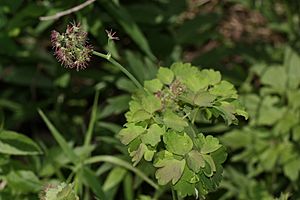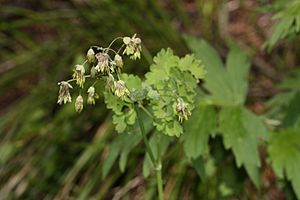Western meadow-rue facts for kids
Quick facts for kids Western meadow-rue |
|
|---|---|
 |
|
| Female flowers (shown) have 1.5 to 2 mm long sepals, no petals, and up to 15 purple stigmas, 3 to 4.5 mm long including the style. | |
| Scientific classification | |
| Genus: |
Thalictrum
|
| Species: |
occidentale
|
The Thalictrum occidentale, also known as western meadow-rue, is a type of flowering plant. It is part of the buttercup family. This plant grows naturally in northwestern North America. You can find it from Alaska and western Canada all the way down to northern California. It also grows in states like Wyoming and Colorado.
Western meadow-rue likes shady places, such as under trees in forests. It also grows in open, wet areas like meadows.
Contents
What Does Western Meadow-Rue Look Like?
The western meadow-rue is a perennial herb. This means it lives for more than two years. It can grow straight up to about one meter tall. The plant can be smooth or have a few soft hairs. It might also feel a bit sticky.
Its leaves are made of many smaller parts. These parts often have three rounded sections. The leaves grow on long, thin stems called petioles.
Flowers and How They Grow
The flowers grow in a tall, upright cluster called a panicle. Sometimes, this cluster might arch over. Small, leaf-like parts called bracts often grow at the bottom of these flower clusters.
Western meadow-rue plants are special because they are dioecious. This means that male flowers and female flowers grow on separate plants.
Male Flowers
The male flowers have a bell-shaped part called a calyx. This calyx is made of four sepals, which are like small leaves that protect the flower bud. These sepals can be greenish-white or purple. Many long, purple stamens hang down from the calyx. The stamens have large tips called anthers.
Female Flowers
The female flowers have a group of tiny, undeveloped fruits. These fruits have purple, thread-like parts called styles at their tips. Each cluster usually has 4 to 9 fruits, but sometimes it can have up to 14.
How Western Meadow-Rue Reproduces
This plant is wind pollinated. This means the wind carries pollen from the male flowers to the female flowers. This is how the plants reproduce and make new seeds.


